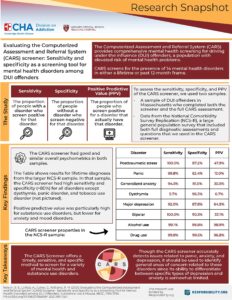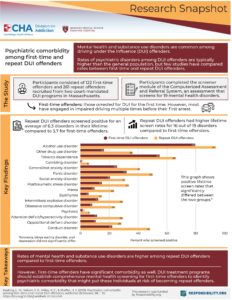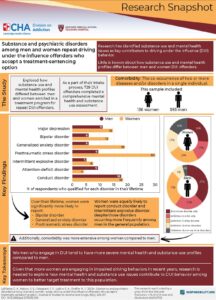
Effective Solutions
Effective Solutions
A comprehensive approach should be implemented in order to identify drug and multiple substance impaired drivers, promote accountability and behavior change including:
Research Snapshots
These snapshots, created in partnership with Harvard’s Cambridge Health Alliance, help explain the link between mental health disorders and impaired driving. They highlight the importance of screening and assessment in prosecuting and sentencing drunk and impaired drivers and aid in identifying underlying catalysts of the choice to drive under the influence.
Additional Solutions Resources
- Jury Selection in Impaired Driving Cases – National District Attorneys Association
- Assessing Impaired Driving through Comprehensive Forensic Toxicology
- Oral Fluid Field Screening (OFFS) & Roadside Drug Testing – Resources
- Oral Fluid Field Sceening (OFFS) Programs – Data Checklist
- Oral Fluid Field Screening (OFFS) Programs – Implementation Checklist
- Proactive Engagement in Traffic Enforcement and Safety
- Hospitals, HIPAA, and Impaired Driving Cases – a Guide for Law Enforcement & Prosecutors
- Specialized Law Enforcement Training
- Cannabis Impairment Detection Workshop Handbook
- Expand Drug Testing for Impaired Drivers
- Law Enforcement Phlebotomy Toolkit
- Expedite Test Collection
- Utilize Effective Technology
- Advanced Vehicle Technology
- RideShare
- Improved Data Collection
- On-Demand Learning: Investigation and Prosecution of Drug-Impaired Driving Cases – National District Attorneys Association (ndaa.org)
Specialized Training
Most law enforcement officers are trained to identify alcohol-impaired drivers, but many do not receive specialized training to identify the signs and symptoms of drug or multiple substance impairment.
Standardized Field Sobriety Testing (SFST)
Every law enforcement officer should be trained in SFST and should have refresher training on a regular basis. https://www.nhtsa.gov/dwi-detection-and-standardized-field-sobriety-test-sfst-resources
Advanced Roadside Impaired Driving Enforcement (ARIDE)
ARIDE training is the bridge between Standardized Field Sobriety Test (SFST) training. The greater the number of ARIDE-trained officers, the more likely that drug and polysubstance-impaired drivers will be identified and DREs will be called upon to perform drug evaluations. https://www.nhtsa.gov/sites/nhtsa.gov/files/documents/aride_participant_manual-tag.pdf
Drug Recognition Expert (DRE) Training
A complete investigation for drug-impaired driving requires an evaluation by a drug recognition expert (DRE). The nation needs more drug recognition experts, especially in rural areas and smaller police and sheriff’s departments. This training requires 2 weeks of in-class instruction followed by a full week of field certification. DREs must be recertified every two years. https://www.nhtsa.gov/enforcement-justice-services/drug-evaluation-and-classification-program-advanced-roadside-impaired
Prosecutor Trainings
Prosecutor training is necessary to help ensure effective prosecution of DUI and DUID cases. Many prosecutors who work these cases are fresh out of law school, yet impaired driving cases are the most complex cases to prosecute. Education is needed to provide an in-depth understanding of how to prosecute impaired driving. The National District Attorneys Association has developed two online trainings that are free and qualify for CLE training. Click here for the DUI course and here for the DUID course. Additionally, most states have at least one traffic safety resource prosecutor whose role is to assist the state’s prosecutors with traffic safety needs and trainings.
Wet Labs and Green Labs
Wet lab and green lab trainings are a great way for law enforcement and prosecutors to learn the signs of alcohol and cannabis impairment. In a controlled environment, volunteers are dosed with various amounts of alcohol or cannabis while attendees learn about the science of alcohol and cannabis impairment. Then attendees are given a chance to observe the volunteers undergo a series of impairment tests and document the results. Responsibility.org and the National District Attorneys Association have published a Cannabis Impairment Detection Workshop Guide with step-by-step instructions on how to host a green lab.
Traffic Safety Resource Toxicology Project
Responsibility.org and the Wisconsin State Laboratory of Hygiene (WSLH) at the University of Wisconsin-Madison created the National Resource Toxicologist Pilot Program. The program is a multi-year (2020-2022) national assessment of forensic toxicology laboratories to identify challenges, successes, gaps, and funding issues related to impaired driving (drugs and alcohol) testing and data.
Toxicology laboratories can provide data that provide better understanding of the full extent of the issue, but widespread resource constraints prohibit forensic toxicology laboratories from testing for a full range of drugs and alcohol, leading to an incomplete picture of the scope of impaired driving in the United States. To better understand the full extent, additional research is needed to assess the financial and operational challenges that toxicology labs face in testing for substances. Many laboratories have implemented limited testing workflows which allow the blood alcohol concentration to dictate when drug testing will occur. This partnership is the first of its kind and will work to uncover what hinderances forensic toxicology labs face in conducting drug and alcohol testing.
WSLH will work with the Society of Forensic Toxicologist staff to collaborate with key government agencies, including the National Highway Traffic Safety Administration (NHTSA), to improve the quality of data and to foster communication with stakeholders such as state highway safety offices, law enforcement, attorneys and judges to gauge the needs of laboratories and ensure thorough communication.
The traffic safety resource toxicologist will also identify the issue and expand the reach and understanding of toxicology with policymakers and criminal justice professionals; consult with states and local agencies; provide training; liaison between toxicology labs and national law enforcement and security partners, toxicology organizations, and universities; serve as a consultant in Frye and Daubert challenges that arise across the country in relation to Driving Under the influence (DUI) and Driving Under the Influence of Drugs (DUID) toxicology and the Drug Recognition Expert (DRE) Program; and, consult on policy issues related to toxicology at the Federal, state, and local level.
For more information about the National Resource Toxicologist Pilot Program, please contact WSLH Forensic Toxicology Section Director Amy Miles at [email protected] or 608-224-6247.
Judicial Training Resources
Judicial training is a critical component in the effort to reduce multiple substance impaired driving. A sentence that aims to identify substance use and mental health disorders, treat them if necessary, and supervision requirements that aim to rehabilitate offenders and reducing recidivism should be every judge’s goal.
Resources:
Community Supervision Training Resources
Most impaired drivers serve their sentence in the community under the supervision of probation officers. Community supervision aims both to protect public safety and to encourage behavior change. To be effective, community supervision officials should rely on the use of validated assessments, proven methods and interagency partnerships.
Of the more than 4.5 million individuals subject to community supervision orders, at least 15% have one impaired driving conviction on their record, and approximately 8% are repeat DUI offenders.
DUI offenders are a challenging population to supervise, and they tend to be inconsistently supervised due to varying procedures across jurisdictions.
When monitoring, accountability, and treatment occur together, community supervision agencies can facilitate long-term behavior change.
Resources:
Expand drug testing for impaired drivers
Expanded testing will strengthen DUI investigations and provide vital information to make appropriate sentencing, supervision, and treatment decisions. If drug use is not identified, offenders are unlikely to be subject to drug testing or treatment interventions while under supervision which means that behavior change is unlikely and the potential for recidivism remains high.
Oral Fluid Testing
Oral fluid tests should be more widely used for roadside screenings to detect presence of drugs, much as a portable breath test (PBT) is used at roadside to detect presence of alcohol.
Oral fluid testing at roadside is fast, reliable, inexpensive, and a relatively non-invasive way to help officers build drug impaired driving cases and expedite investigations in which toxicological evidence may rapidly diminish.
An oral fluid test will inform the officer of what substances, if any, have been used by the driver within about the last 4 hours, not days or weeks prior.
Their use requires reasonable suspicion or probable cause that a driver is impaired, typically following a standardized field sobriety test and other investigative procedures. The roadside screen is used along with other evidence to establish probable cause for arrest.
Roadside screening tests have been used statewide in Alabama and Michigan and the National Highway Traffic Safety Administration (NHTSA) has approved the use of Federal funds in multiple states to implement oral fluid programs. Their use has grown exponentially in the past two years, with over 25 states now conducting testing to some degree.
Oral fluid can also be used as an evidential toxicology sample, depending on state statutes. Evidential tests are analyzed in a toxicology lab similar to blood testing. The samples can be easily collected by law enforcement and do not require medical personnel; they can be collected much earlier in the investigative process than blood. Alabama and New York have evidential oral fluid programs, and Louisiana and Ohio are running pilot programs.
Oral Fluid Screening for Impaired Drivers – Position Paper
Oral Fluid Field Screening (OFFS) & Roadside Drug Testing – Resources
Oral Fluid Field Sceening (OFFS) Programs – Data Checklist
Oral Fluid Field Screening (OFFS) Programs – Implementation Checklist
Electronic Warrants
Electronic Search Warrants help officers quickly obtain a search warrant for blood to accurately determine BAC or toxicology results and streamline the arrest process. Other benefits of e-warrants include reduced workloads, fewer errors, stronger DUI cases, speedier case resolutions, fewer burdens on the system, reduced refusal rates, and public deterrence. Minnesota’s e-Charging platform reduced error rates from 30% to nearly zero and practitioners report increased ease in obtaining warrants. With an e-warrant system, submissions can be prepared in under 10 minutes and the review, approval, and return process can be completed in 15-20 minutes. Implementation recommendations and examples of robust systems can be found in our Guide to Implementing Electronic Warrants. Both the International Association of Chiefs of Police (IACP) and the National Sheriffs’ Association (NSA) have joint resolutions in support of the use of e-warrant systems.
Phlebotomy programs
When suspects refuse BAC tests or when drug use is suspected, a certified medical professional must perform a blood draw. However, emergency department delays are common, and some medical facilities have policies limiting cooperation with law enforcement which can make it difficult to obtain the sample in a timely fashion. To address these issues and others (e.g., chain of custody, testimony, etc.), law enforcement agencies establish phlebotomy programs and certify officers to perform blood draws. Advantages of these programs are highlighted in the NHTSA Law Enforcement Phlebotomy Toolkit include: decreased time from traffic stop to blood sample collection; reduced costs ($40-100/draw); fewer case dismissals; reduced officer overtime pay; improved law enforcement testimony; potential for blood collection at the scene of vehicular homicide/ vehicular assault cases prior to being transported to the hospital; and shorter processing times. Law enforcement phlebotomy began in 1995 when the Arizona Department of Public Safety (DPS) established this program to address concerns about high-BAC refusal rates. After the phlebotomy program was active, statewide refusal rates fell from 20% in 1995 to 6% in 2009. Today, more than 10 states have such phlebotomy programs in place.
Resource: Hospitals, HIPAA, and Impaired Driving Cases – a Guide for Law Enforcement & Prosecutors
Build laboratory capacity
Proof of a defendant’s positive alcohol and/or drug test is important for establishing guilt, but DUI blood samples may take months to process which can result in dismissed cases. Many states struggle with backlog in forensic laboratories that can be in upwards of nine months. Another common concern is a lack of toxicologists available to provide court testimony in complicated DUID cases. Labs need adequate staffing to address these issues. Also, new and advanced testing instrumentation is costly and requires new protocols, procedures, and training. States that wish to allocate highway safety or other grant funding to address any of these issues should be highly encouraged and allowed to do so.
National minimum guidelines in impaired driving cases
Accurate testing will advance understanding of the drug-impaired driving (DUID) problem. Labs should establish/adopt minimum guidelines for toxicological investigations in traffic crashes and drug-impaired driving cases (i.e., drug panels, cut-off levels, and testing procedures) such as those put forth by the National Safety Council (NSC). Lab uniformity is not required but a survey revealed 52% of labs questioned were in partial compliance and motivated to achieve full compliance with NSC recommendations (Logan et al., 2017). State agencies that increase consistency in testing practices will be better positioned to adopt national guidelines if/when these are established.
Expedite Test Collection
Law enforcement officers must be able to gather chemical samples quickly. Drug-impaired driving cases require a blood draw for evidential purposes and delays in obtaining the blood sample pose substantial challenges. Impairment from drug use can last for hours, but the body metabolizes drugs quickly and chemical evidence dissipates rapidly.
Law enforcement phlebotomy
One way to speed the process of blood collection is to train law enforcement officers as lab technicians so they are fully trained to draw blood. This program was first established in Arizona more than two decades ago and is in place in 13 states. Law enforcement phlebotomy saves time and money and alleviates the challenge of performing blood draws in hospitals.
The National Highway Traffic Safety Administration (NHTSA) has published a toolkit that was highlighted in a recent webinar on law enforcement phlebotomy. NHTSA has also established a grant to assist states in setting up phlebotomy programs.
Electronic Warrants
Electronic warrants (e-Warrants) expedite warrant submission and approval, decrease human errors and speed the process for blood testing which will better match nanogram levels to what they were at the time of driving – in other words, the chemical evidence is preserved and not lost to metabolization. Examples of robust e-warrant systems can be found in Arizona, Minnesota, and Utah although each jurisdiction is encouraged to develop a system that is individualized such that it meets specific needs and garners support from key stakeholders. More information about these systems can be found in Responsibility.org’s Implementation Guide.
Utilize Effective Technology
Advances in technology present tremendous opportunity to reduce impaired driving but they are underutilized currently.
In most states, DUIs are not classified as felony offenses until the third or fourth conviction. Many first and second impaired driving offenders are not subject to active supervision, making it difficult to effectively monitor offenders for compliance. Technologies can fill that supervision gap and also improve detection of impaired drivers.
Ignition Interlocks
Ignition interlocks are the most effective countermeasure to stop drunk driving. These devices are in use in all 50 states and D.C. and are mandatory for use among all DUI offenders in 34 states and D.C. However, only about 25 percent of DUI offenders who are required to install ignition interlocks on their vehicles actually do because DUI offenders are often not supervised after sentencing. There are a variety of strategies that states can use to increase ignition interlock implementation such as compliance-based removal, eliminating the ability to wait out a license suspension without interlock installation and allowing restoration of driving privileges if an offender installs an interlock. Click here for more information.
Oral Fluid Tests
Oral Fluid Tests are reliable, fast, non-invasive, and able to detect recent (within 4 hours) drug use. These devices can be used at the roadside to identify the presence and category of drugs among impaired drivers. Click here for more information.
Oral Fluid Field Screening (OFFS) & Roadside Drug Testing – Resources
Oral Fluid Field Sceening (OFFS) Programs – Data Checklist
Oral Fluid Field Screening (OFFS) Programs – Implementation Checklist
Ocular Data Systems and Evidence Recorders
Ocular data systems and evidence recorders allow law enforcement officers to manually test the eye movements and responses of a subject while directly observing and capturing responses in a ‘live’ video. The subject’s captured responses can be stored and played back as evidence of impairment or for instructor critique in training.
Continuous Alcohol Monitoring
Continuous alcohol monitoring provides 24/7 transdermal alcohol testing for repeat impaired drivers. These systems automatically sample the offender’s perspiration every 30 minutes and encourages accountability and can increase compliance rates with court orders and community safety. Click here for more information.
Mobile Fingerprinting Devices
Mobile fingerprinting devices help on-duty police officers verify identities of impaired driving suspects and also allows DUI arrest data to be uploaded to the federal National Crime Information Center database to better identify repeat DUI offenders as they travel between states. Standard arrest protocols often do not include fingerprinting which makes it more difficult to identify repeat DUI offenders.
The DRE Tablet App
The DRE Tablet App was developed by the University of Albany Institute for Traffic Safety Management and Research (ITSMR) to allow law enforcement officers to enter observations and assessments of impaired driving suspects into computer tablets. This electronic process allows data sorting, trend tracking, and informed enforcement efforts.
The DRE tablet app captures all the data required for a Drug Influence Evaluation, and more. The system includes an electronic version of a face sheet, validates data, generates PDF evaluation documents, and uploads all data, including drawings, to a state database. Since the evaluations contain sensitive personal information, data is fully encrypted, and security precautions are in place on both the tablet and the server.
Data collected from the application allows law enforcement agencies to plan their patrols around specific time frames and days of the week when multiple substance and drug-impaired driving violations are most prevalent. Click here for more information.
Electronic Warrants
Electronic Warrants (eWarrants) are an important tool to help law enforcement get impaired drivers off the roads. Automated warrant processes give law enforcement a streamlined tool to ensure people who drive impaired are held accountable. For more information and to learn how to set up these systems, click here and here.
Online Prosecutor Trainings
Online Prosecutor Trainings are necessary to help ensure effective prosecution of DUI cases. Many prosecutors who work on DUI cases are fresh out of law school, yet impaired driving cases are the most complex cases to prosecute. Education is needed to provide an in-depth understanding of how to prosecute impaired driving. The National District Attorneys Association has developed an online training that is free and qualifies for CLE training and will be expanded in 2021 to include drug-impaired driving as well. Click here for more information.
Computerized Screening and Assessment
Computerized Screening and Assessment programs that are validated specifically among DUI offenders are now available. There are three such programs: The Computerized Assessment and Referral System (free to use), the Impaired Driving Assessment (free to use) and the DUI-RANT Assessment. Traditional screening and assessment tools were not developed for the unique risks and needs among impaired drivers. The result has been that an offender’s risk of recidivism, substance use and mental health disorders and treatment needs have not been accurately identified. It is common for impaired drivers to have undiagnosed and untreated substance use and mental health disorders. Without effective identification of these problems, behavior change is unlikely, and they have a higher risk to become repeat offenders.
Advanced Vehicle Technology
Imagine this: A 24-year-old man has consumed some cannabis followed by a few drinks at happy hour. He also takes a prescription medication for ADHD.
On the drive home, his car lets him know he’s not road ready when it senses him leaving his lane and speeding. The car carefully slows down and pulls off the street. He gets a ride share to take him home.
Technology that would stop impaired and dangerous driving exists right now and legislation currently pending in Congress and championed by Mothers Against Drunk Driving (MADD) would move the technology from the research and development phase to future implementation. This technology would save an estimated 9,400 lives a year.
The Honoring Abbas Family Legacy to Terminate Drunk Driving (HALT) Act and the Reducing Impaired Driving for Everyone (RIDE) Act hold the power to virtually eliminate drunk driving.
There are two types of technologies that hold promise:
- Driver monitoring and driving performance monitoring systems can detect signs of distracted, impaired, or fatigued driving by monitoring the driver to assess risk and respond accordingly and/or recognizing erratic or reckless driving as measured by actions of the vehicle. For example, Volvo is adding sensors and cameras to its vehicles aimed at enhancing safety by monitoring drivers for signs of being drunk, impaired by drugs or distracted and intervening to prevent crashes.
- Alcohol detection uses sensors to determine that a driver is at or above the legal blood alcohol concentration (BAC) limit of .08 and then prevents the vehicle from moving.
For more information, contact www.madd.org.
Improved Data Collection
The nation needs better data on impaired driving such as timely and accurate reporting of crash information, including electronic crash reporting systems that allow accurate real- or near real-time uploading of crash information, and impaired driving criminal justice information into Federal, State, and local databases.
Additionally, the National Safety Council has established model guidelines for toxicology testing that include submission of alcohol and drug toxicology results to the National Highway Traffic Safety Administration’s (NHTSA) Fatality Analysis Reporting System to include the type of drug(s) and quantification noted in the toxicology report.
Better data will help determine what actions are most important for communities to implement for reducing multiple substance impaired driving.




